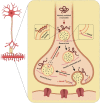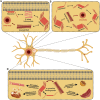α-Synuclein-mediated neurodegeneration in Dementia with Lewy bodies: the pathobiology of a paradox
- PMID: 34798911
- PMCID: PMC8605528
- DOI: 10.1186/s13578-021-00709-y
α-Synuclein-mediated neurodegeneration in Dementia with Lewy bodies: the pathobiology of a paradox
Abstract
Dementia with Lewy bodies (DLB) is epitomized by the pathognomonic manifestation of α-synuclein-laden Lewy bodies within selectively vulnerable neurons in the brain. By virtue of prion-like inheritance, the α-synuclein protein inexorably undergoes extensive conformational metamorphoses and culminate in the form of fibrillar polymorphs, instigating calamitous damage to the brain's neuropsychological networks. This epiphenomenon is nebulous, however, by lingering uncertainty over the quasi "pathogenic" behavior of α-synuclein conformers in DLB pathobiology. Despite numerous attempts, a monolithic "α-synuclein" paradigm that is able to untangle the enigma enshrouding the clinicopathological spectrum of DLB has failed to emanate. In this article, we review conceptual frameworks of α-synuclein dependent cell-autonomous and non-autonomous mechanisms that are likely to facilitate the transneuronal spread of degeneration through the neuraxis. In particular, we describe how the progressive demise of susceptible neurons may evolve from cellular derangements perpetrated by α-synuclein misfolding and aggregation. Where pertinent, we show how these bona fide mechanisms may mutually accentuate α-synuclein-mediated neurodegeneration in the DLB brain.
Keywords: Alzheimer’s disease; Braak hypothesis; Fibrils; Oligomers; Parkinson’s disease.
© 2021. The Author(s).
Conflict of interest statement
The authors declare that they have no competing interests.
Figures



Similar articles
-
Dementia with Lewy bodies and Parkinson's disease-dementia: current concepts and controversies.J Neural Transm (Vienna). 2018 Apr;125(4):615-650. doi: 10.1007/s00702-017-1821-9. Epub 2017 Dec 8. J Neural Transm (Vienna). 2018. PMID: 29222591 Review.
-
Aggregation of alpha-synuclein in Lewy bodies of sporadic Parkinson's disease and dementia with Lewy bodies.Am J Pathol. 1998 Apr;152(4):879-84. Am J Pathol. 1998. PMID: 9546347 Free PMC article.
-
Presynaptic alpha-synuclein aggregates, not Lewy bodies, cause neurodegeneration in dementia with Lewy bodies.J Neurosci. 2007 Feb 7;27(6):1405-10. doi: 10.1523/JNEUROSCI.4564-06.2007. J Neurosci. 2007. PMID: 17287515 Free PMC article.
-
The brainstem pathologies of Parkinson's disease and dementia with Lewy bodies.Brain Pathol. 2015 Mar;25(2):121-35. doi: 10.1111/bpa.12168. Epub 2014 Sep 12. Brain Pathol. 2015. PMID: 24995389 Free PMC article.
-
Parkinson's disease and alpha synuclein: is Parkinson's disease a prion-like disorder?Mov Disord. 2013 Jan;28(1):31-40. doi: 10.1002/mds.25373. Mov Disord. 2013. PMID: 23390095 Review.
Cited by
-
Synapse vulnerability and resilience across the clinical spectrum of dementias.Nat Rev Neurol. 2025 Jul;21(7):353-369. doi: 10.1038/s41582-025-01094-7. Epub 2025 May 22. Nat Rev Neurol. 2025. PMID: 40404832 Review.
-
Toward Personalized Medicine Approaches for Parkinson Disease Using Digital Technologies.JMIR Form Res. 2023 Sep 27;7:e47486. doi: 10.2196/47486. JMIR Form Res. 2023. PMID: 37756050 Free PMC article.
-
Modeling Lewy body disease with SNCA triplication iPSC-derived cortical organoids and identifying therapeutic drugs.Sci Adv. 2024 Sep 13;10(37):eadk3700. doi: 10.1126/sciadv.adk3700. Epub 2024 Sep 11. Sci Adv. 2024. PMID: 39259788 Free PMC article.
-
In Pancreatic Adenocarcinoma Alpha-Synuclein Increases and Marks Peri-Neural Infiltration.Int J Mol Sci. 2022 Mar 29;23(7):3775. doi: 10.3390/ijms23073775. Int J Mol Sci. 2022. PMID: 35409135 Free PMC article.
-
Advancements in PROTAC-based therapies for neurodegenerative diseases.Future Med Chem. 2025 Mar;17(5):591-605. doi: 10.1080/17568919.2025.2463310. Epub 2025 Feb 11. Future Med Chem. 2025. PMID: 39931801 Review.
References
-
- Kosaka K. Dementia with Lewy bodies. Tokyo: Springer; 2017. History and latest concepts of Lewy body disease and dementia with Lewy bodies; pp. 3–9.
Publication types
LinkOut - more resources
Full Text Sources
Miscellaneous

